Herbs for Increasing Milk Supply
The following describes the use of some herbal treatments for breastfeeding mothers who are having various problems.
Approaches to Increase Milk Supply
It is quite possible that herbal remedies help increase milk supply. There are several drugs that obviously do increase milk supply, and of course it is reasonable to assume that some plants and herbs might contain similar pharmacological agents. Almost every culture has some sort of herb or plant or potion to increase milk supply. Some may work as placebos, which is fine; some may not work at all; some may have one or more active ingredients. Some will have active ingredients that will not increase the milk supply but have other effects, not necessarily desirable. Note that even herbs can have side effects, even serious ones. Natural source drugs are still drugs, and there is no such thing as a 100% safe drug. Luckily, as with most drugs, the baby will get only a tiny percentage of the mother’s dose. The baby is thus extremely unlikely to have any side effects at all from the herbs. Two herbal treatments that seem to increase the milk supply are fenugreek and blessed thistle, in the following dosages:
| Fenugreek: | 3 capsules 3 times a day |
|---|---|
| Blessed Thistle: | 3 capsules 3 times a day, or 20 drops of the tincture 3 times a day |
The tincture container states that blessed thistle should not be taken by nursing mothers, presumably because of the tiny amount of alcohol the mother would get. There are some preparations of both herbs that are labelled “not for use by nursing mothers”. Don’t worry about this; these herbs are safe for the mother to take because so little gets into the milk. Teas also seem to work, but to take enough to make a difference, you will be drinking tea all day and night, since the amount of the herbs you get is much less.
- Fenugreek and blessed thistle seem to work better if you take both, not just one or the other.
- Fenugreek and blessed thistle work quickly. If they do work, you will usually notice a difference within 12- 24 hours of starting taking them. If not, they probably won’t work.
- Fenugreek is often sold as a combination with thyme. Do not buy this combination, but try to get the capsules with fenugreek alone.
- Herbal remedies are not standardized, so though the bottle of fenugreek, for example, may say that it contains 405, 505, 605 or 705 mg/capsule, we do not really know how much of the active ingredient you are taking. Fenugreek has a distinct smell. If you cannot smell it on your skin, you are not taking enough, even if you are taking three capsules three times a day. Ensure that the fenugreek is very fresh and gives off a strong odour when you open the container
- Fenugreek and blessed thistle seem also to work better in the first few weeks than later. In fact they tend to work best in the first week. Domperidone works better after the first few weeks. (See information sheets Domperidone and Stopping for more information.)
- You can take fenugreek and blessed thistle together with domperidone if you feel they are helping. If you take both the herbs and domperidone, take domperidone 3 tablets three times a day at the same time as you take the herbs.
- If you are ready to stop fenugreek and blessed thistle, you can probably stop suddenly, or wean off over a week or so.
- Fenugreek does not cause low blood sugar. Where this rumour came from is unknown.
Other Herbal Treatments that have been used to increase milk supply are:
- alfalfa
- spirulina
- goat’s rue
- raspberry leaf
- fennel
- brewer’s yeast
- stinging nettle
- shatavari
Some Lactation Teas may be effective for some mothers. Again, with no standardization and little empirical evidence it is hard to know. We do hear from many mothers that have helped to increase their milk supply. These include: mother’s milk teas, nursing teas, lactation teas. Certainly, it cannot hurt to try.
Food that may help:
- Eating oatmeal daily,
- garlic in moderation,
- ginger in moderation,
are all thought to help milk supply. Again, it cannot hurt to eat oatmeal or take garlic or ginger.
Many cultures have their own “remedies” that they have found to be helpful. And why not? Fish and Papaya Soup, hot curry dishes, etc—they may help and they certainly cannot hurt.
Homeopathy is another approach that may work and consulting with a good Naturopath or Homeopath may prove helpful.
None of these herbal or food treatments, including blessed thistle and fenugreek, has been proved effective scientifically
Remember! Herbal treatments are only part of the solution to “not enough milk” (see Increase intake of breastmilk and look for videos on how to latch a baby on, how to know the baby is getting milk, how to use information sheet Breast compression, how to use a lactation aid, as well as other information sheets on breastfeeding.
Written and revised (under other names) by Jack Newman, MD, FRCPC, 1995-2005
Revised by Jack Newman MD, FRCPC, IBCLC and Edith Kernerman, IBCLC, 2008, 2009
